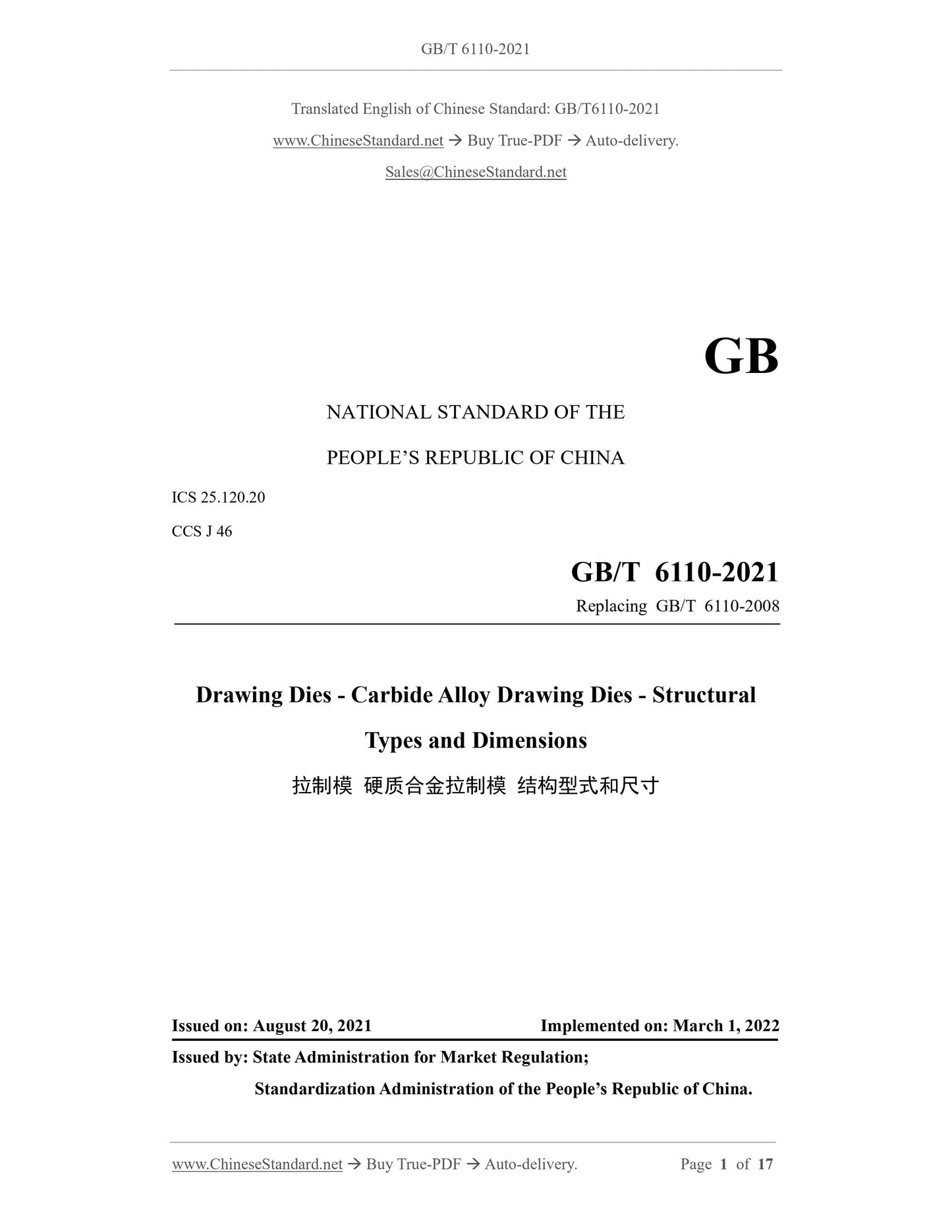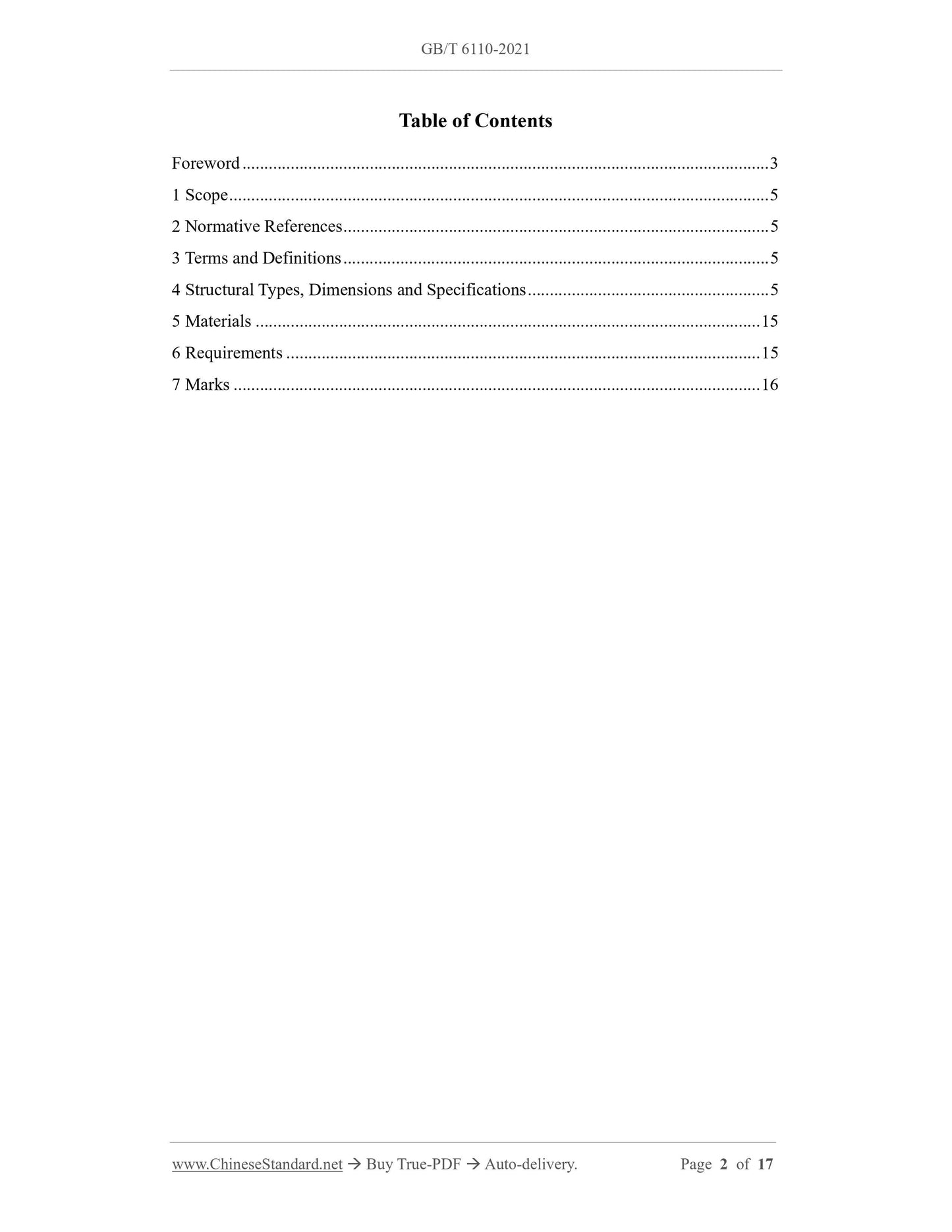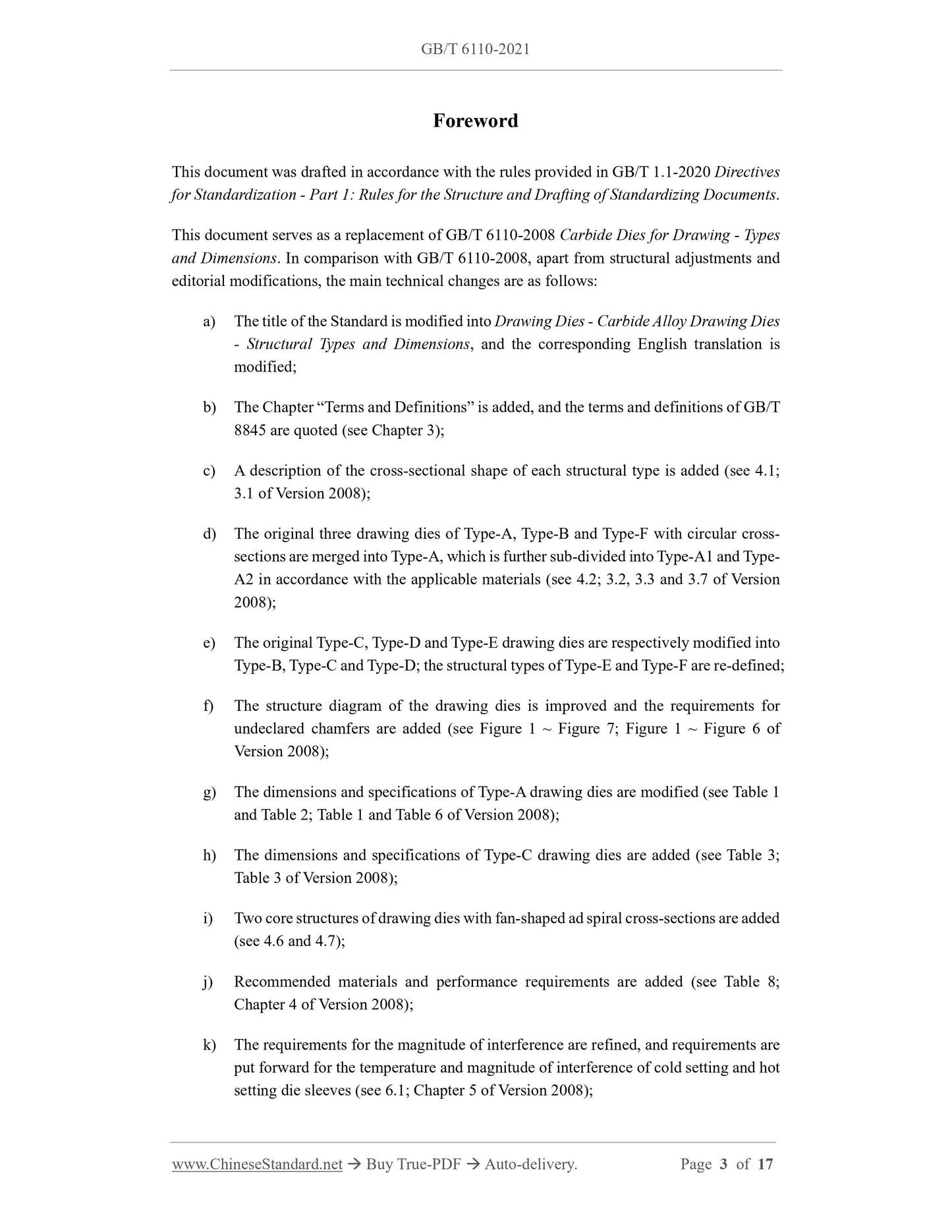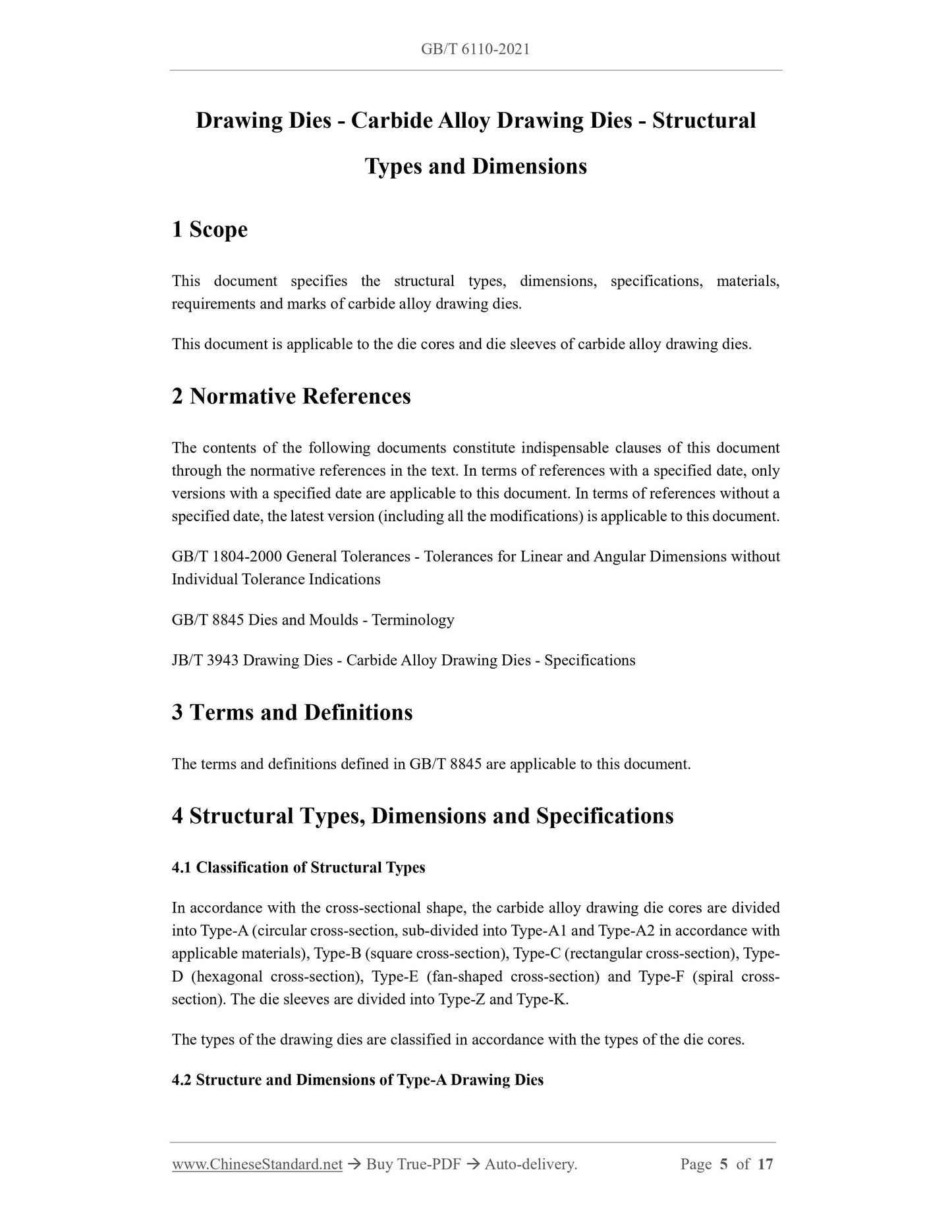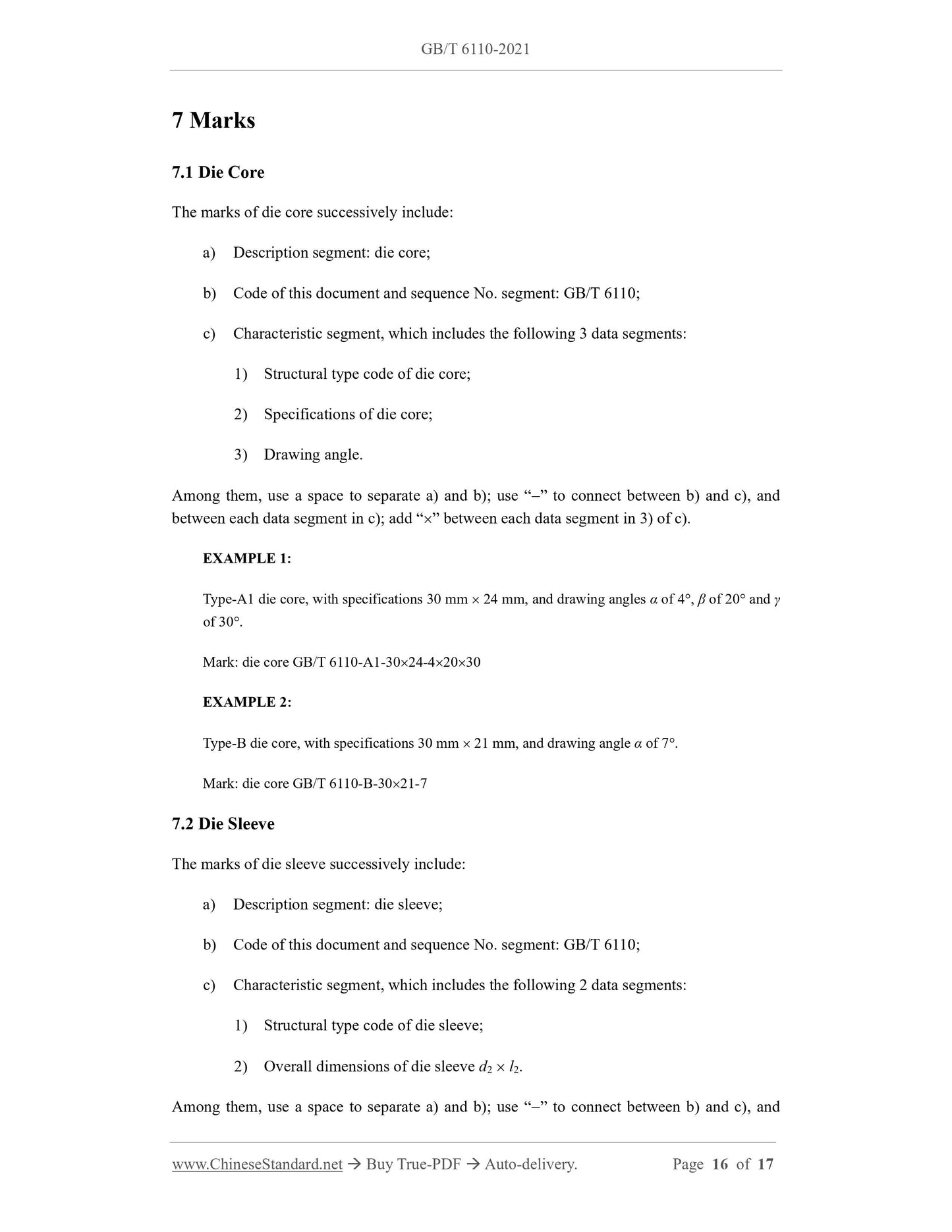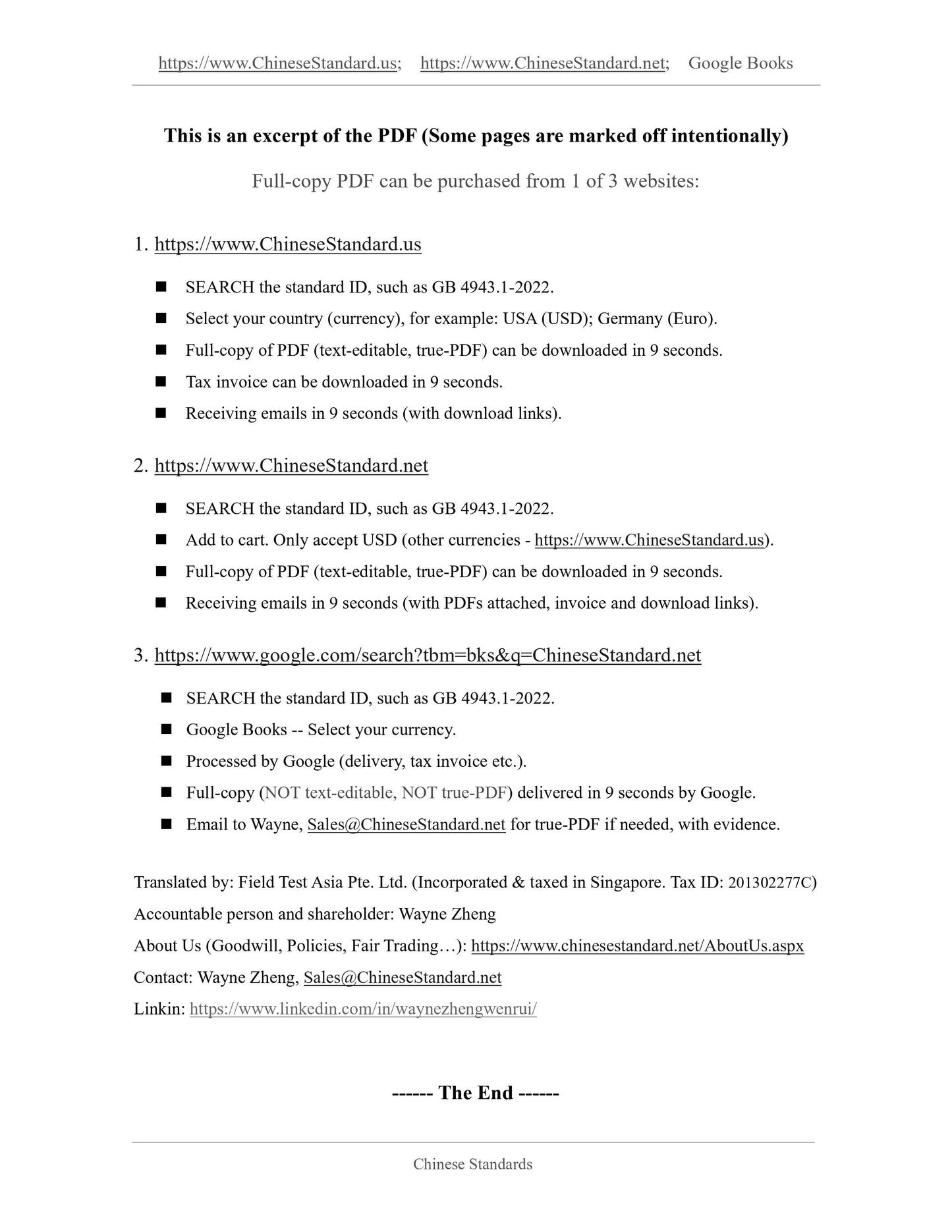1
/
of
6
PayPal, credit cards. Download editable-PDF and invoice in 1 second!
GB/T 6110-2021 English PDF (GBT6110-2021)
GB/T 6110-2021 English PDF (GBT6110-2021)
Regular price
$230.00 USD
Regular price
Sale price
$230.00 USD
Unit price
/
per
Shipping calculated at checkout.
Couldn't load pickup availability
Delivery: 3 seconds. Download true-PDF + Invoice.
Get QUOTATION in 1-minute: Click GB/T 6110-2021
Historical versions: GB/T 6110-2021
Preview True-PDF (Reload/Scroll if blank)
GB/T 6110-2021: Drawing dies -- Carbide alloy drawing dies -- Structural types and dimensions
GB/T 6110-2021
GB
NATIONAL STANDARD OF THE
PEOPLE’S REPUBLIC OF CHINA
ICS 25.120.20
CCS J 46
Replacing GB/T 6110-2008
Drawing Dies - Carbide Alloy Drawing Dies - Structural
Types and Dimensions
ISSUED ON: AUGUST 20, 2021
IMPLEMENTED ON: MARCH 1, 2022
Issued by: State Administration for Market Regulation;
Standardization Administration of the People’s Republic of China.
Table of Contents
Foreword ... 3
1 Scope ... 5
2 Normative References ... 5
3 Terms and Definitions ... 5
4 Structural Types, Dimensions and Specifications ... 5
5 Materials ... 15
6 Requirements ... 15
7 Marks ... 16
Foreword
This document was drafted in accordance with the rules provided in GB/T 1.1-2020 Directives
for Standardization - Part 1: Rules for the Structure and Drafting of Standardizing Documents.
This document serves as a replacement of GB/T 6110-2008 Carbide Dies for Drawing - Types
and Dimensions. In comparison with GB/T 6110-2008, apart from structural adjustments and
editorial modifications, the main technical changes are as follows:
a) The title of the Standard is modified into Drawing Dies - Carbide Alloy Drawing Dies
- Structural Types and Dimensions, and the corresponding English translation is
modified;
b) The Chapter “Terms and Definitions” is added, and the terms and definitions of GB/T
8845 are quoted (see Chapter 3);
c) A description of the cross-sectional shape of each structural type is added (see 4.1;
3.1 of Version 2008);
d) The original three drawing dies of Type-A, Type-B and Type-F with circular cross-
sections are merged into Type-A, which is further sub-divided into Type-A1 and Type-
A2 in accordance with the applicable materials (see 4.2; 3.2, 3.3 and 3.7 of Version
2008);
e) The original Type-C, Type-D and Type-E drawing dies are respectively modified into
Type-B, Type-C and Type-D; the structural types of Type-E and Type-F are re-defined;
f) The structure diagram of the drawing dies is improved and the requirements for
undeclared chamfers are added (see Figure 1 ~ Figure 7; Figure 1 ~ Figure 6 of
Version 2008);
g) The dimensions and specifications of Type-A drawing dies are modified (see Table 1
and Table 2; Table 1 and Table 6 of Version 2008);
h) The dimensions and specifications of Type-C drawing dies are added (see Table 3;
Table 3 of Version 2008);
i) Two core structures of drawing dies with fan-shaped ad spiral cross-sections are added
(see 4.6 and 4.7);
j) Recommended materials and performance requirements are added (see Table 8;
Chapter 4 of Version 2008);
k) The requirements for the magnitude of interference are refined, and requirements are
put forward for the temperature and magnitude of interference of cold setting and hot
setting die sleeves (see 6.1; Chapter 5 of Version 2008);
Drawing Dies - Carbide Alloy Drawing Dies - Structural
Types and Dimensions
1 Scope
This document specifies the structural types, dimensions, specifications, materials,
requirements and marks of carbide alloy drawing dies.
This document is applicable to the die cores and die sleeves of carbide alloy drawing dies.
2 Normative References
The contents of the following documents constitute indispensable clauses of this document
through the normative references in the text. In terms of references with a specified date, only
versions with a specified date are applicable to this document. In terms of references without a
specified date, the latest version (including all the modifications) is applicable to this document.
GB/T 1804-2000 General Tolerances - Tolerances for Linear and Angular Dimensions without
Individual Tolerance Indications
GB/T 8845 Dies and Moulds - Terminology
JB/T 3943 Drawing Dies - Carbide Alloy Drawing Dies - Specifications
3 Terms and Definitions
The terms and definitions defined in GB/T 8845 are applicable to this document.
4 Structural Types, Dimensions and Specifications
4.1 Classification of Structural Types
In accordance with the cross-sectional shape, the carbide alloy drawing die cores are divided
into Type-A (circular cross-section, sub-divided into Type-A1 and Type-A2 in accordance with
applicable materials), Type-B (square cross-section), Type-C (rectangular cross-section), Type-
D (hexagonal cross-section), Type-E (fan-shaped cross-section) and Type-F (spiral cross-
section). The die sleeves are divided into Type-Z and Type-K.
The types of the drawing dies are classified in accordance with the types of the die cores.
4.2 Structure and Dimensions of Type-A Drawing Dies
7 Marks
7.1 Die Core
The marks of die core successively include:
a) Description segment: die core;
b) Code of this document and sequence No. segment: GB/T 6110;
c) Characteristic segment, which includes the following 3 data segments:
1) Structural type code of die core;
2) Specifications of die core;
3) Drawing angle.
Among them, use a space to separate a) and b); use “” to connect between b) and c), and
between each data segment in c); add “” between each data segment in 3) of c).
EXAMPLE 1:
Type-A1 die core, with specifications 30 mm 24 mm, and drawing angles α of 4, β of 20 and γ
of 30.
Mark: die core GB/T 6110-A1-3024-42030
EXAMPLE 2:
Type-B die core, with specifications 30 mm 21 mm, and drawing angle α of 7.
Mark: die core GB/T 6110-B-3021-7
7.2 Die Sleeve
The marks of die sleeve successively include:
a) Description segment: die sleeve;
b) Code of this document and sequence No. segment: GB/T 6110;
c) Characteristic segment, which includes the following 2 data segments:
1) Structural type code of die sleeve;
2) Overall dimensions of die sleeve d2 l2.
Among them, use a space to separate a) and b); use “” to connect between b) and c), and
Get QUOTATION in 1-minute: Click GB/T 6110-2021
Historical versions: GB/T 6110-2021
Preview True-PDF (Reload/Scroll if blank)
GB/T 6110-2021: Drawing dies -- Carbide alloy drawing dies -- Structural types and dimensions
GB/T 6110-2021
GB
NATIONAL STANDARD OF THE
PEOPLE’S REPUBLIC OF CHINA
ICS 25.120.20
CCS J 46
Replacing GB/T 6110-2008
Drawing Dies - Carbide Alloy Drawing Dies - Structural
Types and Dimensions
ISSUED ON: AUGUST 20, 2021
IMPLEMENTED ON: MARCH 1, 2022
Issued by: State Administration for Market Regulation;
Standardization Administration of the People’s Republic of China.
Table of Contents
Foreword ... 3
1 Scope ... 5
2 Normative References ... 5
3 Terms and Definitions ... 5
4 Structural Types, Dimensions and Specifications ... 5
5 Materials ... 15
6 Requirements ... 15
7 Marks ... 16
Foreword
This document was drafted in accordance with the rules provided in GB/T 1.1-2020 Directives
for Standardization - Part 1: Rules for the Structure and Drafting of Standardizing Documents.
This document serves as a replacement of GB/T 6110-2008 Carbide Dies for Drawing - Types
and Dimensions. In comparison with GB/T 6110-2008, apart from structural adjustments and
editorial modifications, the main technical changes are as follows:
a) The title of the Standard is modified into Drawing Dies - Carbide Alloy Drawing Dies
- Structural Types and Dimensions, and the corresponding English translation is
modified;
b) The Chapter “Terms and Definitions” is added, and the terms and definitions of GB/T
8845 are quoted (see Chapter 3);
c) A description of the cross-sectional shape of each structural type is added (see 4.1;
3.1 of Version 2008);
d) The original three drawing dies of Type-A, Type-B and Type-F with circular cross-
sections are merged into Type-A, which is further sub-divided into Type-A1 and Type-
A2 in accordance with the applicable materials (see 4.2; 3.2, 3.3 and 3.7 of Version
2008);
e) The original Type-C, Type-D and Type-E drawing dies are respectively modified into
Type-B, Type-C and Type-D; the structural types of Type-E and Type-F are re-defined;
f) The structure diagram of the drawing dies is improved and the requirements for
undeclared chamfers are added (see Figure 1 ~ Figure 7; Figure 1 ~ Figure 6 of
Version 2008);
g) The dimensions and specifications of Type-A drawing dies are modified (see Table 1
and Table 2; Table 1 and Table 6 of Version 2008);
h) The dimensions and specifications of Type-C drawing dies are added (see Table 3;
Table 3 of Version 2008);
i) Two core structures of drawing dies with fan-shaped ad spiral cross-sections are added
(see 4.6 and 4.7);
j) Recommended materials and performance requirements are added (see Table 8;
Chapter 4 of Version 2008);
k) The requirements for the magnitude of interference are refined, and requirements are
put forward for the temperature and magnitude of interference of cold setting and hot
setting die sleeves (see 6.1; Chapter 5 of Version 2008);
Drawing Dies - Carbide Alloy Drawing Dies - Structural
Types and Dimensions
1 Scope
This document specifies the structural types, dimensions, specifications, materials,
requirements and marks of carbide alloy drawing dies.
This document is applicable to the die cores and die sleeves of carbide alloy drawing dies.
2 Normative References
The contents of the following documents constitute indispensable clauses of this document
through the normative references in the text. In terms of references with a specified date, only
versions with a specified date are applicable to this document. In terms of references without a
specified date, the latest version (including all the modifications) is applicable to this document.
GB/T 1804-2000 General Tolerances - Tolerances for Linear and Angular Dimensions without
Individual Tolerance Indications
GB/T 8845 Dies and Moulds - Terminology
JB/T 3943 Drawing Dies - Carbide Alloy Drawing Dies - Specifications
3 Terms and Definitions
The terms and definitions defined in GB/T 8845 are applicable to this document.
4 Structural Types, Dimensions and Specifications
4.1 Classification of Structural Types
In accordance with the cross-sectional shape, the carbide alloy drawing die cores are divided
into Type-A (circular cross-section, sub-divided into Type-A1 and Type-A2 in accordance with
applicable materials), Type-B (square cross-section), Type-C (rectangular cross-section), Type-
D (hexagonal cross-section), Type-E (fan-shaped cross-section) and Type-F (spiral cross-
section). The die sleeves are divided into Type-Z and Type-K.
The types of the drawing dies are classified in accordance with the types of the die cores.
4.2 Structure and Dimensions of Type-A Drawing Dies
7 Marks
7.1 Die Core
The marks of die core successively include:
a) Description segment: die core;
b) Code of this document and sequence No. segment: GB/T 6110;
c) Characteristic segment, which includes the following 3 data segments:
1) Structural type code of die core;
2) Specifications of die core;
3) Drawing angle.
Among them, use a space to separate a) and b); use “” to connect between b) and c), and
between each data segment in c); add “” between each data segment in 3) of c).
EXAMPLE 1:
Type-A1 die core, with specifications 30 mm 24 mm, and drawing angles α of 4, β of 20 and γ
of 30.
Mark: die core GB/T 6110-A1-3024-42030
EXAMPLE 2:
Type-B die core, with specifications 30 mm 21 mm, and drawing angle α of 7.
Mark: die core GB/T 6110-B-3021-7
7.2 Die Sleeve
The marks of die sleeve successively include:
a) Description segment: die sleeve;
b) Code of this document and sequence No. segment: GB/T 6110;
c) Characteristic segment, which includes the following 2 data segments:
1) Structural type code of die sleeve;
2) Overall dimensions of die sleeve d2 l2.
Among them, use a space to separate a) and b); use “” to connect between b) and c), and
Share
